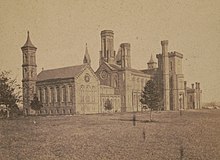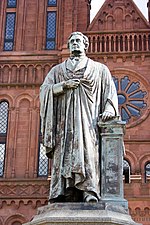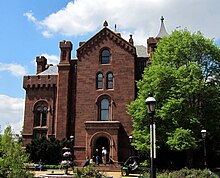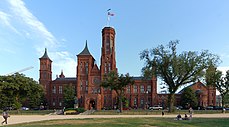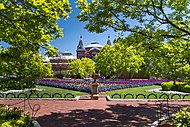
The Smithsonian Institution, or simply the Smithsonian, is a group of museums, education and research centers, the largest such complex in the world, created by the U.S. government "for the increase and diffusion of knowledge." Founded on August 10, 1846, it operates as a trust instrumentality and is not formally a part of any of the three branches of the federal government. The institution is named after its founding donor, British scientist James Smithson. It was originally organized as the United States National Museum, but that name ceased to exist administratively in 1967.

James Renwick Jr. was an American architect in the 19th century, noted especially for designing churches and museums. The Encyclopedia of American Architecture calls him "one of the most successful American architects of his time".

The Corcoran Gallery of Art is a former art museum in Washington, D.C., that is now the location of the Corcoran School of the Arts and Design, a part of the George Washington University.

The Arts and Industries Building is the second oldest of the Smithsonian museums on the National Mall in Washington, D.C. Initially named the National Museum, it was built to provide the Smithsonian with its first proper facility for public display of its growing collections. The building, designed by architects Adolf Cluss and Paul Schulze, opened in 1881, hosting an inaugural ball for President James A. Garfield. It was designated a National Historic Landmark in 1971. After being closed since 2004 for repair and renovation, the building reopened in 2021 with a special exhibition, Futures.

The Smithsonian American Art Museum is a museum in Washington, D.C., part of the Smithsonian Institution. Together with its branch museum, the Renwick Gallery, SAAM holds one of the world's largest and most inclusive collections of art, from the colonial period to the present, made in the United States. More than 7,000 artists are represented in the museum's collection. Most exhibitions are held in the museum's main building, the Old Patent Office Building, while craft-focused exhibitions are shown in the Renwick Gallery.

Romanesque Revival is a style of building employed beginning in the mid-19th century inspired by the 11th- and 12th-century Romanesque architecture. Unlike the historic Romanesque style, Romanesque Revival buildings tended to feature more simplified arches and windows than their historic counterparts.

The Renwick Gallery is a branch of the Smithsonian American Art Museum located in Washington, D.C. that displays American craft and decorative arts from the 19th to 21st century. The gallery is housed in a National Historic Landmark building that was opened in 1859 on Pennsylvania Avenue and originally housed the Corcoran Gallery of Art. When it was built in 1859, it was called "the American Louvre", and is now named for its architect James Renwick Jr.

Oak Hill Cemetery is a historic 22-acre (8.9 ha) cemetery located in the Georgetown neighborhood of Washington, D.C., in the United States. It was founded in 1848 and completed in 1853, and is a prime example of a rural cemetery. Many famous politicians, business people, military people, diplomats, and philanthropists are buried at Oak Hill, and the cemetery has a number of Victorian-style memorials and monuments. Oak Hill has two structures which are listed on the National Register of Historic Places: the Oak Hill Cemetery Chapel and the Van Ness Mausoleum.
The Old Patent Office Building is a historic building in Washington, D.C. that covers an entire city block between F and G Streets and 7th and 9th Streets NW in the Penn Quarter section of Chinatown. Serving as an art gallery for the Smithsonian Institution since the 1960s, it first served as one of the earliest Patent Office buildings.
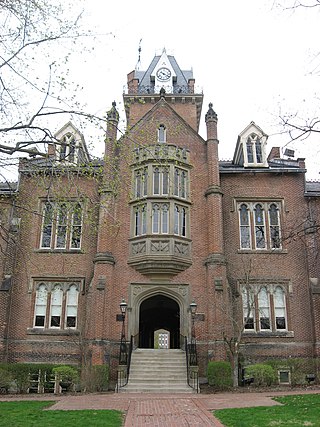
Old Main, Bethany College is a historic building group on the Bethany College campus in Bethany, West Virginia.

The Treasury Building in Washington, D.C., is a National Historic Landmark building which is the headquarters of the United States Department of the Treasury. An image of the Treasury Building is featured on the back of the United States ten-dollar bill.
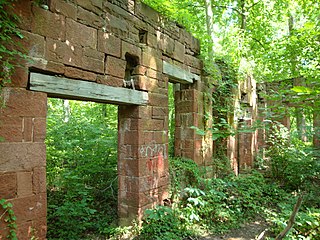
Seneca Quarry is a historic site located at Seneca, Montgomery County, Maryland. It is located along the Chesapeake and Ohio Canal on the north bank of the Potomac River, just west of Seneca Creek. The quarry was the source of stone for two Potomac River canals: the Patowmack Canal on the Virginia side of Great Falls; and the C&O Canal, having supplied red sandstone for the latter for locks 9, 11, 15 - 27, and 30, the accompanying lock houses, and Aqueduct No. 1, better known as Seneca Aqueduct, constructed from 1828 to 1833.

The Oak Hill Cemetery Chapel, also known as the Renwick Chapel or James Renwick Chapel, is a historic building in the Georgetown neighborhood of Washington, D.C., United States. Designed by James Renwick Jr. in 1850, Oak Hill Cemetery Chapel is the architect's only known example of Gothic Revival church architecture in Washington, D.C. It is located on the highest ridge in Oak Hill Cemetery, near the intersection of 29th and R Streets NW. The chapel is one of two structures in Oak Hill Cemetery listed on the National Register of Historic Places, the other being the Van Ness Mausoleum. The chapel, mausoleum, and cemetery are contributing properties to the Georgetown Historic District, a National Historic Landmark.

The Alexandria City Hall also known as the Alexandria Market House & City Hall, in Alexandria, Virginia, is a building built in 1871 and designed by Adolph Cluss. It was listed on the U.S. National Register of Historic Places in 1984. The site was originally a market from 1749 and courthouse from 1752. A new building was constructed in 1817 but after an extensive fire in 1871 it was rebuilt as a replica of the former building.
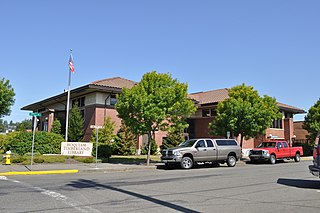
The Carnegie Library is a historic building still in use as the Hoquiam Timberland Library in Hoquiam, Washington.
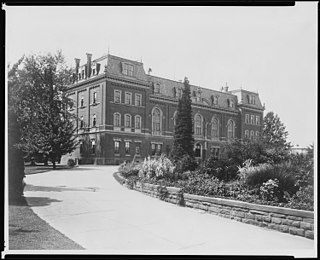
The Department of Agriculture Building was the original headquarters of the United States Department of Agriculture located on the National Mall between 12th and 14th Street SW in Washington, D.C. after its creation in 1862. It was first occupied in 1868. However, it was not compatible with the McMillan Plan and was subsequently demolished in 1930.

Washington, D.C., the capital of the United States, has a unique and diverse architectural history. Encompassing government, monumental, commercial, and residential buildings, D.C. is home to some of the country's most famous and popular structures designed by some of the leading architects of their time. The popularity of the city's buildings is reflected in the findings of a 2007 poll of Americans by the American Institute of Architects, which found that six of the top 10 most popular U.S. structures were located in Washington, D.C. Overall, the poll found, 17 of the top 150 most popular structures were located in the capital.
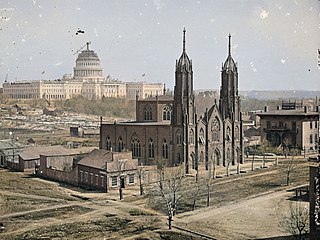
Trinity Episcopal Church was an Episcopal church that stood from 1851 to 1936 on the northeast corner of 3rd and C Streets NW in the Judiciary Square neighborhood of Washington, D.C.


